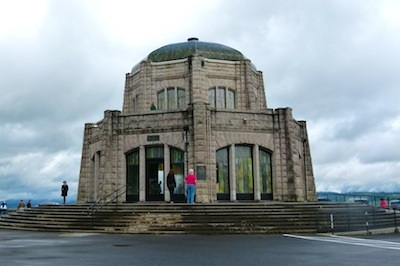Shore Excursion: Stopping at beautiful, expensive comfort station
Build a modern highway through a breathtaking part of the country and you’ll soon realize that you need something else for all those motorists.
That’s right, construction of a “comfort station” began soon after sections of the Columbia River Highway opened. But this is no ordinary bathroom stop.
“These are probably the most beautiful bathrooms you will ever go to,” said Ryan Downs, heritage leader of the S.S. Legacy.
On a shore excursion from the ship, we are cruising the historic Columbia River Highway aboard our luxury bus. And it soon becomes apparent that this marvelous stretch of road was not constructed for big vehicles.
“It was built for Model T Fords,” Downs said as our bus cruised down a very narrow way. “Cars were still kind of a luxury item back in that time … But our bus driver Ed is a Jedi master with this bus.”
And so he is.
The road project started, Downs said, when Pacific Northwest investor and entrepreneur Sam Hill took a train ride through the Columbia River Gorge and saw nature’s treasures.
“It blew his mind,” Downs said. “But there were no roads out here. It was still the frontier back then but it became Sam Hill’s goal to build roads so people could see what he saw.”
Sam Hill and his goal for ‘good roads’
As the area’s most vocal “good roads” spokesman, Hill convinced lawmakers and businessmen to help construct a major highway along the Columbia River. In 1913, work began with Samuel C. Lancaster as project engineer.
Considered one of the greatest engineering feats of the modern age, the highway was designed by Lancaster with a major goal in mind – not to mar what God had put there. The highway was designed to spotlight the many waterfalls and other beautiful spots along the way.
“There are about 70 waterfalls within 20 miles,” Downs said. “It’s pretty wonderful that someone designed a highway to see the beauty of this area, not just to get from one place to another.”
Surfaced with Warrenite, a patented long-wearing and smooth-riding asphaltic-concrete pavement, the Columbia River Highway was completed in 1922. It was patterned after the Axenstrasse in Switzerland and became the first modern highway constructed in the Pacific Northwest and the first scenic highway in the United States.
As we rolled along the magnificent highway, Downs pointed out the rustic stone walls and white wooden fences that line the old road. They are pretty, for sure, but they also served a function – to keep Model T drivers on the new touring road with its perilous cliffs and winding route.
Lancaster designed the rails so that they didn’t distract from the view. Instead, the rails seems to frame the surrounding natural landscape.
KING OF THE ROADS
Called “The King of the Roads,” the 75-mile highway in the state of Oregon between Troutdale and The Dalles drew motorists who, of course, needed potty breaks. That’s where the Vista House at Crown Point came in. In the words of the Oregonian, it was “intended to be the finishing achievement for the greatest highway in America” and “to grace the highest spot on that wonderway.”
The place chosen for Vista House was a spot above Crown Point, a rocky promontory 693 feet above the Columbia River. Vista Point architect Edward M. Lazarus – brother of Emma Lazarus who wrote the poem on the Statue of Liberty – had a grand architectural vision for his rest stop and he definitely succeeded.
Lazarus designed the building to be a “a temple to the natural beauty of the Gorge” and a memorial to the settlers who had made their own trek along the Columbia River, venturing westward on the Oregon Trail.
The result is a 55-foot high structure of gray sandstone and glazed green tops sitting atop one of Oregon’s most inspiring vantage points, inviting visitor’s eyes to travel from the lights of Portland to a faraway bend in the river 12 miles to the east.
“It was a great engineering marvel,” Downs said. “The house is actually built onto a cliff.”
The octagonal building with its copper dome houses a small museum, gift shop, coffee shop and interpretive display of historic and geologic points of interest in the Gorge.
Formally dedicated on May 5, 1918, the facility boasts lovely Tokeen Alaskan Marble for the floors and stairs in the rotunda and as wainscoting on the basement walls. Vista House is open daily mid-March through October and on weekends during the winter when volunteers are available and weather permit. Admission is free.
The completed building cost $99,148.05 which caused an Oregon Journal editorial to label it “the most expensive comfort station in the world.”
That may be true. It certainly is one of the most unusual and beautiful I have ever seen.
Photo by Jackie Sheckler Finch















View Recent Comments